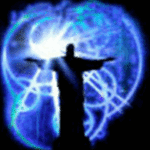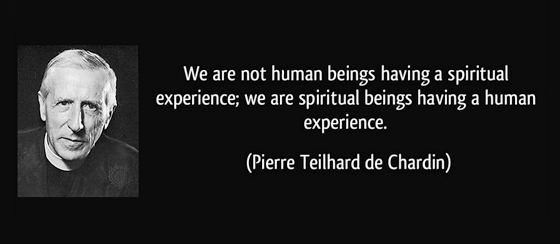In the first half of the 20th century (1881-1955), a French Jesuit priest, Fr. Teilhard de Chardin SJ, combined his theological, philosophical and scriptural studies with a growing interest in the structure of rocks and fossils (geology), the material aspects of the universe (palaeontology) and in the far distant origins, evolution and ultimate purpose and end of the universe (cosmology).
 His work combines religion, spirituality and science in a comprehensive, harmonious and dynamic whole. It portrays a deep spiritual vision of the interior unity, complexity, diversity and evolving consciousness of all creation and the whole universe with God. It portrays God as still actively involved in creating His universe and guiding all humanity forwards and upwards in ever-evolving and deepening consciousness towards Himself.
His work combines religion, spirituality and science in a comprehensive, harmonious and dynamic whole. It portrays a deep spiritual vision of the interior unity, complexity, diversity and evolving consciousness of all creation and the whole universe with God. It portrays God as still actively involved in creating His universe and guiding all humanity forwards and upwards in ever-evolving and deepening consciousness towards Himself.
Evolving human consciousness refers to one’s level of self-awareness and one’s relatedness to others, to the whole of creation and to God. It refers to one’s inner ability to act freely and not compulsively, to be fully alive with joy and hope for the future and openness to infinite possibilities in the evolution from matter to spirit to full unity with Omega God.
For Chardin, ‘Evolution is a light illuminating all facts’ about the universe and its relationship with God. Chardin combines science and religion into a form of mysticism that sheds an ever-deepening understanding and spiritual illumination on both.
 Chardin’s comprehensive vision (‘an impassioned vision of the earth’; Chardin) was birthed in the inhumanity of the First World War. Chardin refused a commission as an officer, his entitlement as a priest, and chose instead to serve as a stretcher-bearer with a mostly Muslim regiment. Within that vision he likened the world-changing ‘harnessing for God the energies of Love’ with the ancient, world-changing discovery of fire. Both can radiate massive energy. The recognition of God’s unconditional and eternal love would set the world on fire with new, divine energy infusing the actions of men and women.
Chardin’s comprehensive vision (‘an impassioned vision of the earth’; Chardin) was birthed in the inhumanity of the First World War. Chardin refused a commission as an officer, his entitlement as a priest, and chose instead to serve as a stretcher-bearer with a mostly Muslim regiment. Within that vision he likened the world-changing ‘harnessing for God the energies of Love’ with the ancient, world-changing discovery of fire. Both can radiate massive energy. The recognition of God’s unconditional and eternal love would set the world on fire with new, divine energy infusing the actions of men and women.
Chardin developed a new way of understanding the evolution of the cosmos. However, the Vatican and his Jesuit superiors, overreacting to the anti-religion extremes of 18th century Enlightenment, were antagonistic towards evolutionary theory. His work on Original Sin was deemed by them to be in error. They had a radically different world vision from Fr. Teilhard de Chardin and thus forbade him to publish any further work to avoid the possibility of future theological error. Chardin responded with complete obedience throughout the whole of his lifetime.
However, his all-encompassing theory of evolution, perhaps better described as a cosmic vision for the whole universe and crafted in his various writings published after his death, now seems to have much to offer religion in general, and Christian theology, spirituality and ecology in particular, in spite of its complexity and specialised terminology. His vision is the basis of a new theology, spirituality and ecology, often coming through other movements. His ideas have been quoted and used by Pope St. John Paul 11, Pope emeritus Benedict XVI, Cardinal Avery Dulles SJ, Cardinal Christoph Schönborn, and many others, including the well-known blogger and spiritual author Fr. Richard Rohr OFM (founder of Centre for Action and Contemplation). I suspect it will shine through much of Pope Francis’ forthcoming encyclical on climate change.
Chardin’s wider and deep vision of evolution reflects the universal Christology of St. Paul, especially in his letter to the Church at Colossae (1:15); “He (Christ) is the image of the unseen God, the first-born of all creation, for in him were created all things in heaven and earth.” It also reflects the mysticism of John the Evangelist; ‘In the beginning was the Word: the Word was with God and the Word was God. Through him all things came into being, not one thing came into being except through him.’ (John 1:1& 2). A brief exposition of the relevant theologies of these two New Testament writers will help reveal the scriptural foundation of much of Chardin’s complex and comprehensive vision of evolution – a vision which he sees as underlying all theories about Jesus the Christ, creation, the universe and evolution.
The mysticism of John the Evangelist is reflected in Chardin’s portrayal of the sense of consciousness of God’s presence and self-communication within all humanity, creating a divine union between Creator and created and between all created being and all of creation – the human and material universe; “Anyone who loves me will keep my word, and my Father will love him and we shall come to him and make a home in him.” (John 14:23 and Ch. 24). John often refers to God abiding in us and we in Him; “He who eats my flesh and drinks my blood abides in me and I in him.” (John 6:56). It is not that we and God are one and the same person but that, while remaining distinct, God abides intimately within everyone He creates and they within Him. Every human being is thus essentially a divine spirit, inhabiting a human body for a while before transforming through death to be eternally and spiritually present with God. This is what some theologians call ‘a communion of will and action’, an immanent presence in a community of life and love and through programmes reaching out in mercy and practical love to others. It is Love that holds the community together. Chardin’s work incorporates John’s mysticism of God’s love (c.f. John’s great odes to God’s love in 1 John 4:7-10 & John 15:9-17); ‘God is the unlimited depth of love of all that is, a love that overflows into a new life.’ (Chardin).
 The creation of the universe commenced, according to modern scientific estimates, around fourteen to 16 billion years ago. According to Teilhard de Chardin, it has been evolving from the very beginning in complexity, unity-in-diversity, inter-dependence and consciousness. Complexity is material complexity. Unity is the unity of matter and spirit into life, unity of inner-consciousness of the self and outer-consciousness of the fundamental relationship of self to all others and to the whole universe and finally to unity of intimate fellowship between Creator and all of His creation – the ultimate Omega Point of evolution.
The creation of the universe commenced, according to modern scientific estimates, around fourteen to 16 billion years ago. According to Teilhard de Chardin, it has been evolving from the very beginning in complexity, unity-in-diversity, inter-dependence and consciousness. Complexity is material complexity. Unity is the unity of matter and spirit into life, unity of inner-consciousness of the self and outer-consciousness of the fundamental relationship of self to all others and to the whole universe and finally to unity of intimate fellowship between Creator and all of His creation – the ultimate Omega Point of evolution.
Teilhard de Chardin posited the view that the world as we know it has been, and still is, evolving and expanding onwards, outwards and upwards to Omega God, the cosmic Christ. Omega was a term used by the evangelist John when he refers to Jesus in his New Testament Book of Revelation (1:18) as “the Alpha and the Omega….who is, who was and who is to come, the Almighty.” For Chardin, this Omega Point is the eternal Christ of divine revelation in whom and to whom all evolution is moving. This point of convergence will reach perfection in the Parousia, the perfect realisation of the Kingdom of God, when Jesus the Christ returns to earth in all His glory, bringing forth the perfect unity of God and humankind, spirit and matter, sacred and secular, Creator and all that He created.
Evolution, for Chardin, is not a blind or mindless process. He sees it as a divinely guided process of creation-in-progress rather than creation completed and now static. His is a dynamic understanding of God. It is of a God intimately, continuously and lovingly involved with ongoing creation and humanity. The mystery of the incarnation is that in Jesus the spiritual and material dimensions of the universe co-exist in perfect harmony. To that Omega point of perfect harmony – “what we are to be in the future” (1 John 3:2) – all creation is evolving and unfolding. Jesus of Nazareth, eternal and Second Person of the Blessed Trinity became the cosmic, universal Christ within all creation and for all time through His death, resurrection and ascension. Those three acts gave universality, unity, freedom and complexity, powered by love and the indwelling Spirit, to the future trajectory of evolution. The evolutionary development of the world will bring all humanity and all of creation to the recognition of that divine Presence and the power of love. Chardin talked of ‘the holiness of evolution’.
Chardin developed a cosmic theology of Jesus the Christ, to match, or balance, the important human aspects of incarnational theology; “The image of the invisible God, the firstborn of all creation” (Paul in Colossians 1:15). The ‘cosmic Christ’ is Christ at one with, and intimately involved in, His universe. Chardin’s evolutionary vision is more about the evolution of universal human consciousness and ‘the interior of things’ – the essence of matter and of the human and material milieu that unites all creation – than about the evolution of ‘the exterior of things’ – as in Darwinian evolutionary theory. However, he saw all matter as having the potential to evolve into more complex and divergent states of being (which he terms ‘cosmogenesis’), with increasing levels of consciousness. Chardin’s vision of evolution embraces the whole of the cosmos, the whole of creation, the whole of humanity and the whole human person – matter, mind and spirit. For Chardin, humanity is not a passive receptacle of evolutionary processes but an active participant in them. Where he alive today he might add that human beings sometimes seriously damage nature and thwart its divine purpose by their sinful greed and ecological ignorance or indifference. Chardin sees evolution as a dynamic movement forwards and upwards to Christ, and the whole of creation as being in a continuing process of evolutionary development – creation in the process of becoming, of becoming again one-with-God.
Teilhard de Chardin’s vision for the universe is full of hope. It is deeply embedded in the material world he studied so carefully and in the God He served so faithfully. His knowledge of the Bible and his experience of the sacramental life of the Catholic Church were an integral part of that vision. Chardin’s spirituality is one of full engagement with the world and joy in its materiality. At the incarnation, materiality became the tabernacle of God Among Us. He understands God to be fully, actively and eternally present in the world, in both its spiritual and material dimensions, in the ‘innerness’ and ‘outerness’ of things. Within that presence God is eternally transforming and redeeming creation, increasing the spiritualisation of matter, the material grounding of spirituality and the deepening of human consciousness.
 Chardin understood matter as evolving into life and inner consciousness, and human life and inner consciousness into personal and universal ‘at-one-ness’ with Jesus the Christ –spiritual consciousness – the Omega point of evolving creation. For Chardin, inner consciousness becomes integrated thinking, the conscious layer of creation which spreads or evolves around the earth like its physical atmosphere and unites people (the world wide web?). He terms this layer the ‘noosphere’. Human consciousness enables the whole of creation to become aware of itself. This is not pantheism, a belief that God and the created universe are one and the same thing. It is a belief in God as soteriologically infusing the world with His divine presence. God is the ultimate reality underlying and supporting the whole of creation. In Buddhism, this is termed ‘Aum’, in Hinduism ‘brahman’, in Judaism ‘Shekinah’ and in Christianity ‘The Kingdom of God’. For Teilhard de Chardin it is Omega; “Omega, He towards whom all converge, is concurrently He from whom all radiate. Impossible to place Him as a focus at the summit of the universe, without at the same time diffusing His presence in the intimate heart of the smallest movement of evolution.” (Chardin). When that complete convergence occurs, the Kingdom of God will have reached its full perfection on earth. As we grow and deepen in our spirituality, so will our relationship with, and appreciation and knowledge of the Christ. As Fr. Richard Rohr OFM has written (The Universal Christ) “When we speak of Christ, we are speaking of an ever-growing encounter, and never a fixed package that is all-complete and must be accepted as is.”
Chardin understood matter as evolving into life and inner consciousness, and human life and inner consciousness into personal and universal ‘at-one-ness’ with Jesus the Christ –spiritual consciousness – the Omega point of evolving creation. For Chardin, inner consciousness becomes integrated thinking, the conscious layer of creation which spreads or evolves around the earth like its physical atmosphere and unites people (the world wide web?). He terms this layer the ‘noosphere’. Human consciousness enables the whole of creation to become aware of itself. This is not pantheism, a belief that God and the created universe are one and the same thing. It is a belief in God as soteriologically infusing the world with His divine presence. God is the ultimate reality underlying and supporting the whole of creation. In Buddhism, this is termed ‘Aum’, in Hinduism ‘brahman’, in Judaism ‘Shekinah’ and in Christianity ‘The Kingdom of God’. For Teilhard de Chardin it is Omega; “Omega, He towards whom all converge, is concurrently He from whom all radiate. Impossible to place Him as a focus at the summit of the universe, without at the same time diffusing His presence in the intimate heart of the smallest movement of evolution.” (Chardin). When that complete convergence occurs, the Kingdom of God will have reached its full perfection on earth. As we grow and deepen in our spirituality, so will our relationship with, and appreciation and knowledge of the Christ. As Fr. Richard Rohr OFM has written (The Universal Christ) “When we speak of Christ, we are speaking of an ever-growing encounter, and never a fixed package that is all-complete and must be accepted as is.”
The whole of creation is permeated by the active presence of God, its creator, whose Holy Spirit ultimately guides the evolutionary process towards completeness in God, its original and continuing Creator. Chardin sees creation as it was poetically described by the Jesuit poet Gerard Manly Hopkins: “The world is charged with the grandeur of God.” The great hope contained in Chardin’s vision is that, while human sin draws humankind away from God, the resurrection of Jesus will eventually win-back all creation to God and restore the primal relationship of Creator and created, to the relationship intended by God at the first moment of creation; when God looked at what he had created “He saw that it was good” (Genesis); “for God so love the world” (John 3:16)
For Chardin, the expansion of the universe is not a geographical expansion into outer space but rather an expansion into an increasing range of as yet unknown dimensions, from the current five dimensions of time, space-length, space-breadth, space-depth and the still not universally recognised spiritual dimension of the universe, to other, perhaps more complex, dimensions. (Modern superstring theory posits ten such dimensions.) Only the spiritual dimension, through the silence of contemplation, can ‘learn’ otherwise unknown truths, make one aware of God’s inner presence throughout all creation and bring peace and healing to the soul. These dimensions govern the universe and the laws of nature. Omega Christ is the Essential Unity holding all creation in all its dimensions and complexity together. He is at the heart of all matter, within what Chardin terms a ‘divine milieu’, a concept flowing from St. Paul’s vision of Jesus the Christ as “In him we live and move and have our being.” (Acts 17:28)
For Chardin, mature spirituality is full engagement with the world, not hiding from it. It is engagement with matter, not despising it as sinful but as infused with the very presence of God. Humankind evolved from matter and it is through the consciousness of humankind that the universe observes itself. Humanity is ‘the axis and arrow of evolution’ (Chardin). Spirit and matter, soul and body, are two dimensions of the one reality, two dimensions in harmonious relationship with each other, with others, with the whole of creation and with God. The spirit component infusing matter propels it towards ever greater integration and ever higher forms of consciousness towards Omega Christ. In biblical/Hebrew terms, the body is the temple of the Holy Spirit – of the Presence of God within matter.
This is very different from those aspects of ancient Egyptian and Greek philosophy and cosmology – the Platonic dualism dividing matter and spirit from each other, body from soul. This division was later adopted by St. Augustine and had a dominant influence on the moral theology of the Church from the 4th century onwards. It permeated much Church ethics and spirituality and still does. In that philosophy spirit and matter are seen as at constant war with each other within the human person; changing and inferior matter warring against unchanging and superior spirit. Matter (bodily functions) was seen as intrinsically evil, the source of all sin. It imprisoned the soul. Independent spirit (mind, consciousness and soul), on the other hand, was the source of all goodness. ‘While we are in the body, and while the soul is infected with the evils of the body, our desire will not be satisfied. And our desire is of the truth. For the body is a source of endless trouble to us because of the mere requirement of food.’ (Plato’s Phaedo). Hence the material body and its functions, especially its feelings, emotions and sexual drive, were to be feared and despised and constantly disciplined, even to the point of flagellation.
 Chardin’s conception of the universe is very different. He sees matter and spirit as a dynamic unity of two elements in an intimate relationship with each other, each infused with the divine and each contributing the grace of its own unique charisms. Chardin, for example, would never have seen the bodily materiality of sexual activity within a faithful relationship as something verging on the sinful, as did St. Augustine, and hence ontologically inferior to virginity and celibacy. He would have seen it as a reavowal of a couples’ covenant love and need for each other, as participation in the divine creativity of God which both creates new life and creates and reflects the love which is the divine energy binding all human life together. ‘God is the unlimited depth of love of all that is, a love that overflows into new life.’ (Chardin). Chardin’s position reflects that of the Bible wherein there is no cosmological antithesis between matter and spirit. Humanity (spirit and matter), created in the image of God, is redeemed by God incarnating Himself into the material matter of the universe which He had created ‘and saw that it was good’ (Genesis) and calling everyone into a fellowship of unconditional love with Him and with each other. Pope Francis colourfully describes this full involvement in the life of the material universe as taking on ‘the smell of the sheep’.
Chardin’s conception of the universe is very different. He sees matter and spirit as a dynamic unity of two elements in an intimate relationship with each other, each infused with the divine and each contributing the grace of its own unique charisms. Chardin, for example, would never have seen the bodily materiality of sexual activity within a faithful relationship as something verging on the sinful, as did St. Augustine, and hence ontologically inferior to virginity and celibacy. He would have seen it as a reavowal of a couples’ covenant love and need for each other, as participation in the divine creativity of God which both creates new life and creates and reflects the love which is the divine energy binding all human life together. ‘God is the unlimited depth of love of all that is, a love that overflows into new life.’ (Chardin). Chardin’s position reflects that of the Bible wherein there is no cosmological antithesis between matter and spirit. Humanity (spirit and matter), created in the image of God, is redeemed by God incarnating Himself into the material matter of the universe which He had created ‘and saw that it was good’ (Genesis) and calling everyone into a fellowship of unconditional love with Him and with each other. Pope Francis colourfully describes this full involvement in the life of the material universe as taking on ‘the smell of the sheep’.
As men and women evolved in the consciousness of their individual personhood, they also evolved into universal socialised beings. They evolved into needing each other in a way reflective of the divine Trinitarian community of Creativity (Father), Love (Holy Spirit) and Relationship (Son). These individual (personal) and universal (community) aspects of evolving creation and human consciousness will eventually converge into the Omega point of all evolution, into Christ Himself. The energy propelling and directing that evolutionary process is Love, eventually making itself known in Jesus the Christ as eternal, unconditional love, as the love which says “I shall not forget you. Look, I have engraved you in the palms of my hands.” (Isaiah 49:15-16). That was the love of a father for his prodigal son, the love demonstrated by the redeeming death and resurrection of Jesus the Christ.
Jesus the Christ is at the centre and apex of the evolving universe. His divine love gives it meaning, purpose and direction as we are drawn imperceptibly into God’s eternal and unconditional love in Omega Christ. A major result of Jesus the Christ being the Cosmic Christ is that every human being, in whom He resides and through whom He continues His evolving creation and universal redemption, is thus a cosmic and divine person too – a central and intrinsic part of the whole material universe while throbbing with divine life and the divine energy of the Spirit.
Meditation on God’s Word in the Bible, the silent prayer of contemplation (transformation and understanding without words and thoughts) and practical love and mercy for others are ancient ways for each of us to be at one with the cosmic evolution of all creation. They aid our final, eternal and perfect transformation and incorporation into cosmic Christ, foreshadowed now in Eucharist – Christ’s programme of strengthening us to outreach to others in mercy and practical, loving actions, especially to the poor, marginalised and downtrodden.
The role of Christianity, and other world religions, is for their individual members, and the faith community as a body, to reveal to all humankind – through the love, joy and hope that radiate from their lives – the inner divine Presence and all-encompassing divine Love, as they ‘proclaim the Good News to all creation’ (Mark 16:15) and grope their pilgrim way onwards, outwards and upwards to Omega Christ.
More can be found out about Fr. Teilhard de Chardin’s vision of evolution in his major works, published after his death: The Divine Milieu (1927), The Vision of the Past (1935), Building the Earth (1937), The Phenomena of Man (1940), and The Future of Man (1941).

